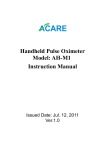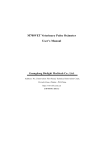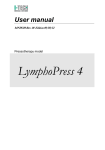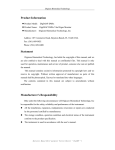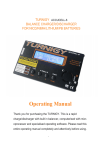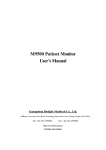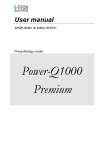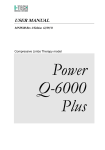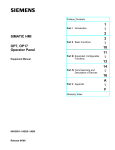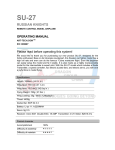Download PocketSigns PS8x - Digicare Biomedical
Transcript
PocketSigns PS8x Monitor User’s Manual rev1 Product Information Product Model: PS8x Product Name: PocketSigns PS8x Manufacturer Name: Contact Information: Digicare Biomedical Technology Inc Address: 107 Commerce Rd, Boynton Beach, Florida, 33426, USA Tel: (561) 689-0408 Fax: (561) 689-0021 Post code: 33426 Revision History This manual has a revision number. This revision number changes whenever the manual is updated due to software or technical specification change. Contents of this manual are subject to change without prior notice. Revision number: 1 Release time: 2011-11 1-1 PocketSigns PS8x Monitor User’s Manual rev1 Statement Manufacturer holds the copyright of this manual, and we are also entitled to deal with this manual as confidential files. This manual is only used for operation, maintenance and service of product, someone else can not publish the manual. This manual contains exclusive information protected by copyright laws and we reserve its copyright. Without written approval of manufacturer no parts of this manual shall be photocopied or translated into other languages. The contents contained in this manual are subject to amendments without notification. Manufacturer's Responsibility Only under the following circumstances will manufacturer be responsible for the safety, reliability and performance of the instrument: All the installation, expansion, readjustment, renovation or repairs are conducted by the personnel certified by manufacturer. The storage condition, operation condition and electrical status of the instrument follow the product specification. The instrument is used in accordance with the user’s manual. 1-2 PocketSigns PS8x Monitor User’s Manual rev1 About this manual This manual contains the instructions necessary to operate the product safely and in accordance with its function and intended use. Observance of this manual is a prerequisite for proper product performance and correct operation, and ensures patient’s and operator’s safety. This manual is based on the maximum configuration and therefore some contents may not apply to your product. If you have any questions, please contact us. This manual is an integral part of the product. It should always be kept close to the equipment so that it can be obtained conveniently when needed. All illustrations in this manual serve as examples only. They may not necessarily reflect the setup or data displayed on your product. Conventions: Bold Italic text is used in this manual to quote the referenced chapter or section. 【】is used to enclose screen texts. → is used to indicate operational procedures. 1-3 PocketSigns PS8x Monitor User’s Manual rev1 Signs in this manual: : Warning: Indicates a potential hazard or unsafe practice that, if not avoided, will result in death or serious injury. Caution: Indicates a potential hazard or unsafe practice that, if not avoided, could result in minor personal injury or product/property damage. Note: Provides application tips or other useful information to ensure that you get the most from your product. 1-4 PocketSigns PS8x Monitor User’s Manual rev1 Contents Chapter 1 General Introduction ................................................1-10 1.1 Intended Use ...................................................................1-10 1.2 Components ....................................................................1-10 1.3 Main Unit ....................................................................... 1-11 1.4 Display Views.................................................................1-16 1.5 Contraindications............................................................1-19 Chapter 2 Safety ...........................................................................2-1 2.1 Safety Information ............................................................2-1 2.2 Explanation of Symbols ....................................................2-3 Chapter 3 Basic Operations .........................................................3-1 3.1 Unpacking and Checking ..................................................3-1 3.2 Getting Started..................................................................3-1 3.3 Starting the monitor ..........................................................3-2 3.4 General Setup ...................................................................3-2 3.5 Date and Time Setup .........................................................3-4 3.6 Selecting the Work Mode ..................................................3-4 3.7 Entering/Exiting the Demo Mode .....................................3-6 3.8 Checking the Version ........................................................3-7 1-5 PocketSigns PS8x Monitor User’s Manual rev1 3.9 Restoring the Factory Configuration .................................3-7 3.10 Shutting off the Monitor .................................................3-7 Chapter 4 Alarm ...........................................................................4-1 4.1 Alarm Categories ..............................................................4-1 4.2 Alarm Levels ....................................................................4-2 4.3 Alarm Indicators ...............................................................4-3 4.4 Alarm Status Symbol ........................................................4-5 4.5 Alarm Tone Configuration ................................................4-6 4.6 Pausing the Alarm Tones...................................................1-1 4.7 Shutting off the Alarm Volume .........................................4-7 4.8 When an Alarm Occurs .....................................................4-8 Chapter 5 Measuring SpO 2 ..........................................................5-1 5.1 Introduction ......................................................................5-1 5.2 Safety Information ............................................................5-1 5.3 Monitoring Procedure .......................................................5-3 5.4 SpO 2 Display ....................................................................5-4 5.5 PR Display........................................................................5-5 5.6 SpO 2 Alarm Setup .............................................................5-5 5.7 PR Alarm Setup ................................................................5-7 1-6 PocketSigns PS8x Monitor User’s Manual rev1 Chapter 6 Measuring ECG...........................................................6-1 6.1 Introduction ......................................................................6-1 6.2 Safety Information ............................................................6-2 6.3 Monitoring Procedure .......................................................6-3 6.4 ECG Display.....................................................................6-6 6.5 ECG Setup ........................................................................6-6 6.6 Hum filter Setup ...............................................................6-7 6.7 HR Alarm Setup................................................................6-7 Chapter 7 Reviewing ....................................................................7-1 7.1 Introduction ......................................................................7-1 7.2 Reviewing Screen .............................................................7-1 7.3 Reviewing Setup ...............................................................7-1 Chapter 8 Battery .........................................................................8-1 8.1 Introduction ......................................................................8-1 8.2 Installing Batteries ...........................................................8-2 8.3 Charging the Lithium Ion Battery .....................................8-6 8.4 Optimizing Battery Performance.......................................8-7 8.5 Checking the Lithium Battery ...........................................8-8 8.6 Disposing of the Batteries.................................................8-9 1-7 PocketSigns PS8x Monitor User’s Manual rev1 Chapter 9 Maintenance and Cleaning .........................................9-1 9.1 Introduction ......................................................................9-1 9.2 Cleaning the Monitor ........................................................9-2 9.3 Cleanin SpO 2 Sensor.........................................................9-3 9.4 Cleaning ECG Cable .........................................................9-3 9.5 Disposal............................................................................9-4 Chapter 10 Accessaries...............................................................10-1 10.1 SpO 2 .............................................................................10-1 10.2 ECG ..............................................................................10-2 AppendixA Product Specifications ............................................10-1 A.1 Safety Specifications .....................................................10-1 A.2 Physical Specifications ..................................................10-1 A.3 Environmental Specifications ........................................10-2 A.4 Charging Specifications .................................................10-2 A.5 Hardware Specifications ................................................10-3 A.6 Data Storage ..................................................................10-5 A.7 Infrared Communication ................................................10-5 A.8 Measurement Specifications...........................................10-6 AppendixB EMC.........................................................................10-8 AppendixC Factory Defaults.................................................... 10-13 1-8 PocketSigns PS8x Monitor User’s Manual rev1 C.1 Alarm Setup ................................................................. 10-13 C.2 System Setup................................................................ 10-14 C.3 SpO 2 Setup ................................................................... 10-14 C.4 ECG Setup ................................................................... 10-14 C.5 Trend Setup .................................................................. 10-15 AppendixD Alarm Message ...................................................... 10-15 D.1 Physiological alarm...................................................... 10-15 D.2 Technical alarm............................................................ 10-16 1-9 PocketSigns PS8x Monitor User’s Manual rev1 Chapter 1 - General Introduction 1.1 Intended Use The PocketSigns PS8x monitor is intended for continuously monitoring or spot checking of SpO 2 , PR, ECG and HR signals of a single adult, pediatric or neonatal patient. This device can be used in institutions or units with health care capability. For instance, outpatient departments, emergency rooms and departments of internal medicine in hospitals, and ordinary departments in clinics, nursing hospitals and medical institutions for communities as well as home care. 1.2 Components This device consists of a main unit, a SpO 2 probe (DB9 plugs), a 3-lead ECG cable, 3 AA batteries, a lithium battery (optional), an AC-DC adapter (optional), an infrared receiving adapter (optional) and a battery charger (optional). 1-10 PocketSigns PS8x Monitor User’s Manual rev1 1.3 Main Unit 1.3.1 Front View Fig 1-1 Front view of the monitor 1. Alarm indicating lamp When an alarm occurs, this lamp will light up as defined below: High level alarm: the lamp quickly flashes red. Medium level alarm: the lamp slowly flashes yellow. Low level alarm: the lamp lights yellow without flashing. 2. Display screen 1-11 PocketSigns PS8x Monitor User’s Manual rev1 3. Left button Press this button to: Enter the main menu under the monitoring screen. Select the highlighted menu item under the menu screen. 4. Right button Press this button to: Change the screen display between Big numeral mode,SpO 2 waveform mode and ECG waveform mode under the monitoring screen. Exit current menu under the menu screen. 5. Alarm pause button It’s invalid to press this button when the alarm volume is off. It can pause the alarm for 120s when the alarm volume is on. It can change the alarm message to import message when “Lead off”or “Sensor off” alarm happens. 6. Power button After the batteries are installed: Press this button to turn on the monitor. Press and hold it for 2 seconds to turn the monitor off. 7. Up button Press this button to: Raise the beat volume under the monitoring screen. 1-12 PocketSigns PS8x Monitor User’s Manual rev1 Move the cursor upwards or increase the value of selected menu item under the menu screen. 8. Down button Press this button to: Lower the beat volume under the monitoring screen. Move the cursor downwards or decrease the value of selected menu item. 9. Battery charging indicating lamp Lights orange when the battery is being charged. Is shuts off when the battery is fully charged or not being charged. 1-13 PocketSigns PS8x Monitor User’s Manual rev1 1.3.2 Rear View 1 2 Fig 1-2 Rear view of the monitor 1. Speaker 2. Battery door 1-14 PocketSigns PS8x Monitor User’s Manual rev1 1.3.3 Side View Top side: Down side: Left side: 5 3 2 4 1 Fig 1-3 Side view of the monitor 1. SpO 2 probe connector 2. ECG cable connector 3. Cord hold 4. Power supply connector It is used to connect the charger stand. 5. Infrared port It is a port through which a personal computer is communicated to export data in real time. 1-15 PocketSigns PS8x Monitor User’s Manual rev1 1.4 Display Views This device has a function of direction sensing. Under monitoring screen, when the angle between the screen and horizontal plane exceeds 60º, corresponding display screen will be shown on the device automatically no matter whether you hold it transversely or longitudinally. 1.4.1 Big Numeric Display Mode 120s 6 7 5 8 4 3 9 2 1 10 11 12 Fig 1-4 Big numeric display mode 1. Menu: After startup, 【Menu】 shows the functions of the left button. At the time, press the left button to enter 【Menu】. 2. Patient ID No.: When 【Continuous】 is selected for work mode, the value is 0 at all times; when 【Spot-Check】 is selected, the value is between 1 and 99. 1-16 PocketSigns PS8x Monitor User’s Manual rev1 3. PR parameter area: Current PR value and its high and low alarm limits are shown in this area. 4. Physiological alarm area: Current physiological alarm information is shown in this area. 5. SpO 2 parameter area: Current SpO 2 value and its high and low alarm limits are shown in this area. 6. Technical alarm and prompt information area: Current technical alarm and prompt information are shown in this area. 7. Alarm status area: Alarm status symbols and alarm pause time are shown in this area. 8. Pleth bar : Pulse intensity is denoted by the quantity of blocks. 9. HR parameter area: HR parameter and its high and low alarm limits are shown in this area. 10. System time: Current time is shown in this area. 11. Shift: After startup, 【Shift】shows the functions of the right button. At the time, press the right button to shift between different display modes. 12. Battery symbol: The symbol indicates the current quantity of electricity of batteries. 1-17 PocketSigns PS8x Monitor User’s Manual rev1 1.4.2 SpO 2 Waveform Display Mode 2 3 1 Fig 1-5 SpO 2 waveform display mode 1. SpO 2 waveform area: The waveform shown in this area is the current SpO 2 volume curve. 2. SpO 2 parameter area: The values shown in this area are the current SpO 2 value and its upper and lower alarm limits. 3. PR parameter area: The values shown in this area are the current PR value and its upper and lower alarm limits. 1-18 PocketSigns PS8x Monitor User’s Manual rev1 1.4.3 ECG Waveform Display Mode 3 2 1 Fig 1-6 ECG Waveform Display Mode 1. ECG waveform display area: Waveform shown in this area is the current ECG waveform. 2. SpO 2 parameter area: The values shown in this area are the current SpO 2 value and its upper and lower alarm limits. 3. HR parameter area: The values shown in this area are the current HR value and its upper and lower alarm limits. 1.5 Contraindications None. 1-19 PocketSigns PS8x Monitor User’s Manual rev1 Chapter 2 - Safety 2.1 Safety Information Warning: Explosion hazard: Do not use the monitor in the presence of flammable anesthetics mixtures with air, oxygen, or hydrogen. When the monitor is in use, there should not be any great power appliances as high voltage cables, X-ray machine, ultrasound equipment and high frequency electronic equipment in use nearby. Keep the monitor away from dust, vibration, corrosive substances, explosive materials, high temperature and moisture. The monitor is not designed for the sterilized room. The monitor should be handled with care so as to avoid shocks and falls. When the monitor is in use, it must be ensured the batteries have sufficient capacity; otherwise there might be such phenomena as starting-up measurement data, etc. 2-1 abnormalities or inaccurate PocketSigns PS8x Monitor User’s Manual rev1 Warning: Do not conduct SpO 2 measurement on the finger smeared with nail polish; otherwise this will lead to unreliable measurement results. Measurements and pulse signals can be affected by certain environmental conditions, sensor application errors, and certain patient conditions. See the appropriate sections of this manual for specific safety information. The use of accessories, sensors, and cables other than those specified may result in increased emission, low anti-disturbance and/or create invalid readings of the monitor. It is advised to check it at least once a month. Caution: In order to have more accurate measurement results, the monitor should be used in a quiet and comfortable environment. 2-2 PocketSigns PS8x Monitor User’s Manual rev1 2.2 Explanation of Symbols Symbol Symbol Note Type CF applied part, defibrillation protected Attention: Consult this manual Direct Current(DC) Alarm volume off Alarm volume pause parameter alarm off Beep volume off Power supply connector Left/right button Up button Down button Date of manufacture Manufacturer 2-3 PocketSigns PS8x Monitor User’s Manual rev1 SN Serial number Power button Symbol for the marking of electrical and electronics devices according to Directive 2002/96/EC. 2-4 PocketSigns PS8x Monitor User’s Manual rev1 Chapter 3 - Basic Operations 3.1 Unpacking and Checking Open the package. In the package are an SpO 2 probes(DB9 plugs), a 3-lead ECG cable, 3 AA batteries, a lithium battery(optional), an AC-DC adapter (optional), an infrared receiving adapter (optional), a battery charger(optional), and user’s manual(this manual). Take out the monitor and its accessories. 3.2 Getting Started 1. Before you start to make measurements, carry out the following checks on the monitor including all connected modules. ——Check for any mechanical damage; ——Check for any incorrect connection of all the external cables and accessories. 2. Put batteries into the battery compartment. Make sure that the battery has sufficient power for monitoring. When you use a lithium battery for the first time, you must charge it, following the instructions given in the Battery chapter. 3-1 PocketSigns PS8x Monitor User’s Manual rev1 Warning: Warning: If the monitor is mechanically damaged, or if it is not working properly, do not use it for any monitoring procedure on a patient. Contact your service personnel. To avoid explosion hazard, do not use the monitor in the presence of flammable anesthetics, vapors or liquids. 3.3 Starting the monitor Press the button to turn on the monitor. For you to use the monitor more conveniently, after starting the monitor you can make the following setting as shown in section 3.4 first. 3.4 General Setup Press the Left button to enter 【Menu】 , then select 【General Setup】 to enter the general setup menu shown as follows. You can set the following parameters’ values. Fig 3-1 General setup window 3-2 PocketSigns PS8x Monitor User’s Manual rev1 3.4.1 Beep Volume Setup Press the Left button to select the item, then, set its value through the Up or Down button. You can select from 0 to 4. 0 is the minimum beep volume while 4 is the maximum one. There will be a sign at the bottom of the monitoring screen to indicate that the beep volume is off when you select 0. 3.4.2 Key Volume Setup Press the Left button to select the item, then, set its value through the Up or Down button. You can select from 0 to 4. 0 is the minimum key volume while 4 is the maximum one. 3.4.3 Adjust the Screen Brightness Press the Left button to select the item, then, set its value through the Up or Down button. You can select from 1 to 5. 1 is the minimum screen brightness while 5 is the maximum one. Selecting the minimum brightness can save power. Caution: If the monitor is used outdoors or the ambient light is strong, set the screen brightness to a higher level. 3.4.4 Scan Speed Setup Press the Left button to select the item, then, set its value through the Up or Down button. You can select from 12.5mm/s to 25mm/s. 3-3 PocketSigns PS8x Monitor User’s Manual rev1 3.5 Date and Time Setup After starting up, you need to set the date and time of this monitor. Operations are as follows: 1. Select 【Menu】→【System】 to enter the System menu shown as follows: Fig 3-2 System setup window 2. Select the year, month and day on the right of 【Date】, and set them to the current date. 3. Select the hour and minute on the right of 【Time】 , and set them to the current time. 3.6 Selecting the Work Mode The monitor is designed to operate in the continuous monitoring and spot-checking mode. Its work mode is shown in the technical alarm area. You can set the monitor’s work mode following these steps: 3-4 PocketSigns PS8x Monitor User’s Manual rev1 1. Select 【 System 】 → 【 Maintenance 】, a password entering window will pop up, input the password and select【OK】to enter the maintenance window shown as follows: Fig 3-3 Maintenance window 2. Select 【Work Mode】 , you can set the monitor’s work mode to 【Continuous】 or 【Spot-Check】 . 3.6.1 Continuous Monitoring Mode The continuous monitoring mode is intended for long-term monitoring. This mode is normally selected when the patient is in hospital or under transport. At the time, the patient ID defaulted by the system is 0. When the memory reaches the above limit, the data stored primarily will be cleared. 3.6.2 Spot-checking Mode Spot-checking mode is intended for short-term on-site measurement. This mode is normally selected to check outpatient when doctors make rounds of the wards. The patient ID will automatically 3-5 PocketSigns PS8x Monitor User’s Manual rev1 increase from 1 to 99. Details are as follows: Apply the SpO 2 sensor to the patient. After valid SpO 2 signals are detected, 1. The patient ID flashes and automatically increases by 1 after 8 seconds to admit a new patient. 2. Press the Left button when the current patient ID is flashing, the patient ID will stop flashing and remain unchanged. The patient will not be admitted and new measurements will be stored under the current patient ID. 3. When the storage of patient measuring data reaches its limit, the newly measuring data will cover for the primary one. 3.7 Entering/Exiting the Demo Mode To enter the demo mode: 1. Select【 Menu】→【System】→【Maintenance】→ enter the required password. 2. Set【 Screen】to【Demo】and the message【Demo Mode】is shown in the technical alarm area. To exit the demo mode: 1. Select【 Menu】→【System】→【Maintenance】→ enter the required password. Set 【Screen】 to 【Normal】 . 3-6 PocketSigns PS8x Monitor User’s Manual rev1 Caution: The Demo mode is for demonstration purposes only. To avoid the simulated data being mistaken for the monitored patient’s data, you should not enter the Demo mode while a patient is being monitored. Otherwise, improper patient monitoring and delayed treatment could result. 3.8 Checking the Version Select【Menu】→【System】, the last line of the menu【Version】 is the version used in the monitor. 3.9 Restoring the Factory Configuration If you have changed the system’s configuration and want to restore the factory configuration, follow this procedure: 1. Select 【Menu】→【System】 . 2. Select【 Load Default Conf.】,poping up a confirming window, select 【OK】 to restore the factory configuration. 3.10 Shutting off the Monitor Please follow these steps to shut off the monitor: 1. Confirm that the patient monitoring is finished. 2. Disconnect the SpO 2 sensors form the monitor. 3-7 PocketSigns PS8x Monitor User’s Manual rev1 3. Press the power button and hold it for 2s to turn off the monitor. Caution: Under the Spot-check mode, if the monitor is not in use and there is no button operation for more than 5 minutes, the monitor will shut down automatically. 3-8 PocketSigns PS8x Monitor User’s Manual rev1 Chapter 4 - Alarm Alarm refers to a prompt that is given by the monitor for medical personnel through visual, audible and other means when a vital sign appears abnormal or the monitor faces technical problem. Note: The monitor generates all the audible and visual alarms through speaker, alarm lamp and screen. 4.1 Alarm Categories By nature, the pulse monitor’s alarms can be classified into three categories: 1. Physiological alarms Physiological alarms are triggered by a monitored parameter value that violates set alarm limits or an abnormal patient condition. Physiological alarm messages are displayed in the physiological alarm area. 2. Technical alarms Technical alarms are triggered by a device malfunction or a patient data distortion due to improper operation or system problems. Technical alarm messages are displayed in the technical alarm area. 4-1 PocketSigns PS8x Monitor User’s Manual rev1 3. Prompt messages As a matter of fact, prompt messages are not alarm messages. Apart from the physiological and technical alarm messages, the pulse monitor will show some messages telling the system status. Prompt messages are displayed in the technical alarm area. 4.2 Alarm Levels 1. By severity, the pulse monitor’s physiological alarms can be classified into three categories: high level alarms, medium level alarms and low level alarms. High level alarms Indicate that the patient is in a life threatening situation and an emergency treatment is demanded. Medium level alarms Indicate that the patient’s vital signs appear abnormal and an immediate treatment is required. Low level alarms Indicate that the patient’s vital signs appear abnormal and an immediate treatment may be required. 2. By severity, the pulse monitor’s technical alarms can be classified into two categories: medium level alarms and low level alarms. 4-2 PocketSigns PS8x Monitor User’s Manual rev1 Caution: The level of technical alarm can’t be changed by the user. 4.3 Alarm Indicators When an alarm occurs, the pulse monitor will indicate it through the following indications: Alarm tone: According to the alarm level, the monitor ’ s speaker gives alarm sounds in different tones. Alarm lamp: According to the alarm level, the monitor ’ s alarm lamp flashes in different color and speed. Alarm message: Alarm messages are displayed on the screen. Flashing numeric: The numeric of the alarm’s parameter flashes. Caution: For different alarm levels, the alarm lamp, alarm tone and alarm messages presented are different. 4.3.1 Alarm tone The different level alarms are indicated by the system in these different audio ways: 4-3 PocketSigns PS8x Monitor User’s Manual rev1 Alarm level Audible prompt High “DO-DO-DO------DO-DO, DO-DO-DO------DO-DO” Medium “DO-DO-DO” Low “DO-” 4.3.2 Alarm Lamp When an alarm occurs, the alarm levels are visually indicated differently in the following ways: Alarm level Visual prompt High Alarm lamp flashes in red with 2 Hz. Medium Alarm lamp flashes in yellow with 0.5 Hz. Low Alarm lamp lights on in yellow without flashing. Caution: When multiple alarms of different levels occur at the same time, the monitor will select the alarm of the highest level and give its visual and audible alarm indications. When multiple alarms occur at the same time, the alarm message will be displayed in the alarm area in turn. 4-4 PocketSigns PS8x Monitor User’s Manual rev1 4.3.3 Alarm Message When an alarm occurs, the alarm message will be displayed in the alarm area. The system uses the following symbols to match the alarm level of physiological alarm messages: High level alarms: *** Medium level alarms: ** Low level alarms: * The system uses different background colors for the alarm message to match the alarm level: High level alarms: red Medium level alarms: yellow Low level alarms: yellow 4.3.4 Flashing Numeric When a physiological alarm occurs, the numeric of parameter flashes. 4.4 Alarm Status Symbol indicates the alarm sound is turned off. indicates the alarm sound is paused. indicates individual measurement alarms are turned off. 4-5 PocketSigns PS8x Monitor User’s Manual rev1 4.5 Alarm Tone Configuration 4.5.1 Setting the minimum Alarm Volume 1. Select【 Menu】→【System】→【Maintenance】→ enter the required password. 2. Select 【Min.Al.Vol】 and then select a value between 0 and 4. 4.5.2 Changing the Alarm Volume 1. Select 【Menu】→【General Setup】 . 2. Select 【Alarm Vol】 and then select a value between X and 4. X is the minimum volume which depends on the setting of the minimum alarm volume, and 10 is the maximum volume. 4.6 Pausing the Alarm Tones Press the alarm pause button to keep the alarm paused for 120 seconds. The alarm paused symbol and paused time will show in the alarm status. The audible alarm is paused, but the alarm lamp remains lit and the alarm message remains displayed; The remaining alarm pause time is displayed in the alarm status area; The symbol is displayed in the alarm status area. 4-6 PocketSigns PS8x Monitor User’s Manual rev1 Audible alarm starts again automatically after the alarm pause period expires. You can also press the key to restart the audible alarm. 4.7 Shutting off the Alarm Volume Set the 【Min.Al.Vol】 and 【Alarm Vol】 to 0 to shut off the alarm volume. Then there wil be a symbol shown in the alarm status area. The alarm lamp and alarm messages are still active after the alarm volume is off. The audible alarm is reactivated automatically when: The factory configuration is loaded; Set the alarm volume to a nonzero value. When a factory configuration is selected, the alarm volume of the monitor may be lower than the minimum alarm volume. In this case the alarm volume is automatically adjusted according to the minimum alarm volume. Warning: When the alarm sound is switched off, the monitor will give no audible alarm tones even if a new alarm occurs. Therefore the user should be very careful about switching off the alarm sound or not. 4-7 PocketSigns PS8x Monitor User’s Manual rev1 Warning: Don’t rely exclusively on the audible alarm system for patient monitoring. Adjusting alarm volume to a low level may result in a hazard to the patient. Always keep the patient under close surveillance. 4.8 When an Alarm Occurs Note: When an alarm occurs, you should always check the patient’s condition first. Check the alarm message appeared on the screen. It is needed to identify the alarm and action appropriately, according to the cause of the alarm. 1. Check the patient’s condition. 2. Identify alarming parameter and alarm category. 3. Identify the cause of the alarm. 4. Silence the alarm, if necessary. 5. When cause of alarm has been solved, check that the alarm system is working properly. You will find the alarm messages for the individual parameter in Appendix D Alarm message . 4-8 PocketSigns PS8x Monitor User’s Manual rev1 Chapter 5 - Measuring SpO2 5.1 Introduction The measurement of oxygen saturation of arterial blood (also known as pulse oxygen saturation, usually shortened as SpO 2 ) adopts the principles of light spectra and volume tracing. The LED emits lights with two specific wavelengths, which are selectively absorbed by oxygenated hemoglobin and deoxyhemoglobin. The optical receptor measures the changes in the light intensity after the light passes the capillary network and estimates the ratio of oxygenated hemoglobin and the total hemoglobin. oxygenated hemoglobin SpO 2 % = oxyhemoglobin + deoxyhemoglobin × 100% 5.2 Safety Information Warning: Use only SpO 2 sensors specified in this manual. Follow the SpO 2 sensor’s instructions for use and adhere to all warnings and cautions. 5-1 PocketSigns PS8x Monitor User’s Manual rev1 Warning: When a trend toward patient deoxygenation is indicated, blood samples should be analyzed by a laboratory co-oximeter to completely understand the patient’s conditions. Do not use the monitor and the SpO 2 sensor during magnetic resonance imaging (MRI). Induced current could cause burns. Prolonged continuous monitoring may increase the risk of unexpected changes in skin characteristics, such as irritation, reddening, blistering or burns. Inspect the sensor site every two hours and move the sensor if the skin quality changes. For neonates, or patients with poor peripheral blood circulation or sensitive skin, inspect the sensor site more frequently. Check the SpO 2 sensor and its package for any sign of damage before use. Do not use the sensor if any damage is detected. When disposing the disposable SpO 2 probe or other SpO 2 probes, please observe all local, state, and federal regulations that relate to the disposal of this products or similar products. 5-2 PocketSigns PS8x Monitor User’s Manual rev1 Caution: In case it is necessary to add a clip to fix the fingertip sensor, the cable instead of the sensor itself should be clipped. Please note that the sensor’s cable should not be pulled with force. Note: The pleth wave is not equal to the intensity of PR signal. The monitor does not provide automatic self-examination alarm signal and the operator has to use SpO 2 simulator for self-examination. 5.3 Monitoring Procedure 1. Selecting SpO 2 Sensor You can select the SpO 2 sensor depending on the patient category, weight and application site. 2. Connecting SpO 2 Sensor Plug the SpO 2 sensor cable into the SpO 2 connector on the measurement module. 5-3 PocketSigns PS8x Monitor User’s Manual rev1 3. Applying SpO 2 Sensor Clean the application site, removing any substance such as nail polish, and apply the sensor to the patient. Warning: Do not use the SpO 2 sensor on a limb where the NIBP cuff is applied. This may result in inaccurate SpO 2 reading due to blocked blood flow during cuff inflation. Do not conduct SpO 2 measurement on the finger smeared with nail polish, otherwise unreliable measurement results might be produced. When using finger sensor, make sure the nail faces to the light window. 5.4 SpO 2 Display Parameter Display 1 5 2 4 3 Fig 5-1 SpO 2 parameter 1. SpO 2 label 2. High alarm limit of SpO 2 3. Low alarm limit of SpO 2 4. SpO 2 value 5. SpO 2 unit 5-4 PocketSigns PS8x Monitor User’s Manual rev1 Waveform Display 1 Fig 5-2 SpO 2 waveform 1. Pleth waveform 5.5 PR Display 1 5 2 4 3 Fig 5-3 PR parameter 1. PR label PR value 2. High alarm limit of PR 3. Low alarm limit of PR 4. 5. PR unit 5.6 SpO 2 Alarm Setup 5.6.1 Switching On/Off SpO 2 Alarm 1. Select 【Menu】→【Alarm Setup】 . 2. Set the SpO 2 【Alarm】 to 【Off】 to shut off SpO 2 alarm. When the SpO 2 alarm is off there is a parameter display area. 5-5 sign in the SpO 2 PocketSigns PS8x Monitor User’s Manual rev1 5.6.1 Seting Alarm Level 1. Select 【Menu】→【Alarm Setup】 . 2. Set the SpO 2 【Alarm】 to 【Med】 or 【High】 . 5.6.2 Adjusting the Alarm Limit 1. Select 【Menu】→【Alarm Setup】 . 2. Adjust 【High】 : If a SpO 2 measurement is higher than the high alarm limit, the “SpO2 Too High” alarm will be triggered. 3. Adjust【Low】: If a SpO 2 measurement is lower than the low alarm limit, the “SpO2 Too Low” alarm will be triggered. 5.6.3 Setting Desat SpO 2 desat means when SpO 2 measuring value is lower than the desat, a high physiological alarm will be trigged. Its setting is as follows: 1. Select【Menu】→【System】→【Maintenance】,then pops up a password entering window. 2. Input the password and select 【OK】 to enter the maintenance window. Select 【Desat Lim.】 , Then set its value through the Up and Down button. 5-6 PocketSigns PS8x Monitor User’s Manual rev1 5.7 PR Alarm Setup 5.7.1 Switching On/Off PR Alarm 1. Select 【Menu】→【Alarm Setup】 . 2. Set the PR 【Alarm】 to 【Off】 to shut off PR alarm. When PR alarm is off there is a sign in the PR parameter display area. 5.7.2 Seting Alarm Level 1. Select 【Menu】→【Alarm Setup】 . 2. Set the PR 【Alarm】 to 【Med】 or 【High】 . 5.7.3 Adjusting the Alarm Limit 1. Select 【Menu】→【Alarm Setup】 . 2. Adjust【High】: If a PR measurement is higher than the high alarm limit, the “PR Too High” alarm will be triggered. 3. Adjust 【Low】 : If a PR measurement is lower than the low alarm limit, the “PR Too Low” alarm will be triggered. 5-7 PocketSigns PS8x Monitor User’s Manual rev1 Chapter 6 - Measuring ECG 6.1 Introduction Before mechanical systole, the heart firstly produces electrical excitement, which results in biological current, and conducts the current to the body surface through tissue and humour. Different potential changes take place at various parts of the body, thus body-surface potential differences are formed. Changes in potential differences are recorded to form the dynamic curve, i.e. ECG, also called body-surface ECG or regular ECG. Through many electrodes connected with ECG cables, the monitor examines the changes of body-surface potential caused by the patient’s heart, observes the ECG activities, records the ECG waveform, and calculates the HR. The monitor can achieve 3-lead monitoring. 6-1 PocketSigns PS8x Monitor User’s Manual rev1 6.2 Safety Information Warning: It is imperative to only use the ECG electrodes and cables provided by manufacturer or specified in this manual. Users shall use the electrode which has little polarization voltage and little contact resistance. Check the ECG cable and its package for any signs of damage before use. Do not use the cable if any damage is detected. When you are connecting the electrodes or the patient cable, make sure that the connectors never come into contact with other conductive parts, or with ground. In particular, make sure that all of the ECG electrodes are attached to the patient, to prevent them from contacting conductive parts or ground. Please check the skin where the electrodes are placed, replace the electrodes or relocate the electrodes in case of skin allergy occurs. When conducting defibrillation, it is imperative to only use the ECG electrodes and cables specified by manufacturer. Interference from instruments near the patient and ESU interference can cause problems with the ECG wave. The monitor cannot be directly applied to heart and cannot be used for the measurement of endocardio ECG. 6-2 PocketSigns PS8x Monitor User’s Manual rev1 6.3 Monitoring Procedure 6.3.1 Skin Preparation Good electrode-to-skin contact is important for a good ECG signal, as the skin is a poor conductor of electricity. It is necessary to deal with the skin properly before placing the electrodes. The steps are shown as follows: 1. Select sites with intact skin, without impairment of any kind. 2. Clip or shave hair from sites as necessary. 3. Gently abrade the skin to remove dead skin cells to improve the conductivity of the electrode site. 4. Wash sites thoroughly with soap and water, leaving no soap residue. (We do not recommend using ether or pure alcohol, because this dries the skin and increases the resistance.) 5. Dry skin thoroughly. 6.3.2 Placing Electrode 1. Preparation before placement 1) Skin preparation (refers to Chapter 7.3.1 ); 2) Check if the buttons on the electrodes are clean and free of damage; 3) Place the electrodes on the patient’s body. Before attaching, smear some conducting cream on the electrodes if the electrodes are not electrolyte self-supplied; 6-3 PocketSigns PS8x Monitor User’s Manual rev1 4) Connect the cable leads to the electrodes through the buttons of the electrodes. Note: For patients who tremble a lot or patients with especially weak ECG signals, it might be difficult to extract the ECG signals, and it is even more difficult to conduct HR count. For severely burnt patients, it may be impossible to stick the electrodes on and it may be necessary to use the special pin-shape electrodes. In case of bad signals, care should be taken to place the electrodes on the soft portions of the muscle. Check the irritation caused by each electrode to the skin, and in case of any inflammations or allergies, the electrodes should be replaced and the user should relocate the electrodes every 24h or at a shorter interval. 2. Electrode Placement Take the AHA standard as an example, when conducting 3-lead ECG monitoring, use 3-lead ECG cable. The three limb-leads of RA, LA and LL as shown in below figure, will be placed on the relevant locations. This connection can establish the lead of I, II, III. 6-4 PocketSigns PS8x Monitor User’s Manual rev1 RA LA LL Fig 6-1 Electrode placement 3. The following table shows the ECG electrode label to identify each electrode and its associated color of AHA and IEC standards. Electrode Electrode Electrode Electrode labels colors labels colors (IEC) (IEC) (AHA) (AHA) Placement Directly below the R Red RA White clavicle and near the right shoulder Directly below the L Yellow LA Black clavicle and near the left shoulder On the left lower F Green LL Red abdomen 6-5 PocketSigns PS8x Monitor User’s Manual rev1 6.4 ECG Display ECG Parameter 5 1 2 4 3 Fig 6-2 ECG Parameter 1. HR label 2. HR high alarm limit 3. HR low alarm limit 4. HR value 5. Heartbeat icon ECG Waveform 1 3 2 Fig 6-3 ECG waveform 1. Lead label 2. ECG scale 3. ECG waveform 6.5 ECG Setup Select【Menu】→【ECG Setup】, Press the up and down button to set 【Lead】 , 【ECG Gain】 and 【Mode】 . Lead : Select an ECG lead as required. You can select from 【 Ⅰ 】 , 【 Ⅱ 】 and 【 Ⅲ 】 . 6-6 PocketSigns PS8x Monitor User’s Manual rev1 ECG Gain :Select an ECG gain as required. You can select from【 × 0.25】 , 【× × 0.5】 and 【 × 1.0】 . Mode :Select a mode as required. You can select from【MON】and 【DIAG】 . 6.6 Hum filter Setup Select【Menu】→【System】→【Maintenance】→【Hun】, Set its value to the local main power frequency. 6.7 HR Alarm Setup 6.7.1 Alarm Switch Setup Select【Menu】→【Alarm Setup】, Set【Alarm】of HR to【Off】 to shut off HR alarm. There is a sign shown in the left corner of HR display area or the HR alarm is on. 6.7.2 Alarm Level Setup Select【 Menu】→【Alarm Setup】, Set【 Alarm】of HR to【Low】, 【Med】 and 【High】 . 6.7.3 Alarm Limit Setup Select【 Menu】→【Alarm Setup】, Set the high/low alarm limit of HR to a value as required. 6-7 PocketSigns PS8x Monitor User’s Manual rev1 Chapter 7 - Reviewing 7.1 Introduction Select【Menu】→【Trend】 to enter trend reviewing window. In the window, you can review SpO 2 and PR data previously stored. 7.2 Reviewing Screen Fig 7-1 SpO 2 /PR reviewing window Above is the SpO 2 /PR review window. In the window, you can review SpO 2 /PR value measured in different times. When SpO2 or PR is over the setting alarm limit, their values are red. If the trend date is over one page, you can turn pages by the up/down button. 7.3 Reviewing Setup After entering the review window, press the left button to enter 【Trend Setup】 window shown as the following: 7-1 PocketSigns PS8x Monitor User’s Manual rev1 Fig 7-2 Trend Setup In the window you can set 【Interval】 , 【Select ID】 , 【Delete Selected】 , 【Delete All】 and 【Export Trend】 : Interval : To adjust recording time interval within the range from 2 seconds to 30 minutes. Select ID :To select patient ID No. The user may change ID No. to browse trend data of related patients. Delete Selected : To delete trend data of the selected ID No. Delete All : To delete trend data of all patients. Export Trend :To send trend data of the selected ID No. before the operation, related computer software must be opened, and the infrared interfaces of the instrument and the computer must be aligned. 7-2 PocketSigns PS8x Monitor User’s Manual rev1 Chapter 8 - Battery 8.1 Introduction The handheld monitor is designed to operate on three 1.5V alkaline AA batteries or a rechargeable lithium ion battery. Under normal circumstances, no special maintenance is needed. When alkaline batteries or a lithium ion battery is used, the battery icon indicates the battery status as follows: 1. Indicates that the power of the battery is full ; 2. Indicates that the power of the battery is 3 grids left ; 3. Indicates that the power of the battery is 2 grids left ; 4. Indicates that the power of the battery is 1 grid left ; 5. Indicates that the battery is almost depleted. Battery power supply can only last for a period of time. If the voltage of batteries is too low, an alarm of “Battery Low” will be triggered. If alkaline AA batteries are used, please change them timely; if a rechargeable battery is used, please insert the monitor to battery 8-1 PocketSigns PS8x Monitor User’s Manual rev1 charger and connect the charger with commercial power to charge the battery. The monitor will be switched off automatically 10 minutes after the first “Battery Low” alarm is given. Caution: Remove the batteries prior to shipping or if the monitor is not likely to be used for an extended period of time. Warning: Use only batteries specified in this manual. Keep the batteries out of children’s reach. When the monitor is not in use for a long time, the battery should be removed from it. Dispose of battery in accordance with local ordinances and regulations. 8.2 Installing Batteries Battery compartment is at the back of the device, please follow the following steps to install or change batteries. 8-2 PocketSigns PS8x Monitor User’s Manual rev1 8.2.1 Opening the Battery Door 1. Turn the monitor off first. 2. Use the screw driver to lose the screw that secures the battery door to the monitor. screw Fig 8-1 Loose the screw 3. Press the battery door, push it downwards and remove the battery door. Fig 88 - 2 Push the battery door 8-3 PocketSigns PS8x Monitor User’s Manual rev1 8.2.2 Installing the Alkaline Battery 1. Insert the AA alkaline batteries in the battery compartment, aligning the + on each battery with the + shown inside the battery compartment. 2. Close the battery door and push it upwards. 3. Tighten the screw that secures the battery door to the pulse monitor. Caution: Check the batteries periodically for corrosion. Replace batteries if corrosion is present, otherwise damage to the monitor may occur. Do not run the pulse monitor using alkaline batteries of different types or capacities at the same time. 8.2.3 Installing the Lithium Ion Battery 1. Insert the lithium ion battery in the battery compartment, shown as follows: 8-4 PocketSigns PS8x Monitor User’s Manual rev1 Press the battery in Fig 8-3 Install the battery 2. Close the battery door and push it upwards. 3. Tighten the screw that secures the battery door to the pulse monitor. Warning: Do not use the charger stand when the alkaline batteries is depleted or no battery is installed. Disconnect the monitor from the patient and stop monitoring before charging the battery. When connecting the running monitor to the AC-DC adapter to charge its battery, there will be a message displayed on the screen, and the monitor will shut down after 10 seconds. 8-5 PocketSigns PS8x Monitor User’s Manual rev1 8.3 Charging the Lithium Ion Battery Handheld monitor Battery charger AC/DC adapter Fig 8-4 Charging device To charge the lithium ion battery: 1. Place the pulse monitor in the charger stand. 2. Connect the AC-DC adapter and plug the adapter into the AC mains. 3. The indicating lamp on the battery charger and the indicating lamp on the monitor are on to indicate that the battery is in charge. 4. When the battery charging indicating lamp on the monitor turns off, the battery is fully charged. 8-6 PocketSigns PS8x Monitor User’s Manual rev1 8.4 Optimizing Battery Performance A battery needs at least two optimizing cycles when it is put into use for the first time. A battery cycle is one complete, uninterrupted charge of the battery, followed by a complete, uninterrupted discharge of the battery. A battery should be conditioned regularly to maintain its useful life. Condition a battery once when it is used or stored for two months, or when its run time becomes noticeably shorter. To optimize a battery, follow this procedure: 1. Disconnect the monitor from the patient and stop all monitoring and measuring procedures. 2. Place the battery in need of optimizing into the battery compartment to the monitor. 3. Place the monitor in the charger stand and connect the AC mains. Allow the battery to be charged uninterruptedly for over 4 hours. 4. Remove the AC mains and allow the monitor to run from the battery until it shuts off. 5. Replace the monitor in the charger stand and connect the AC mains. Allow the battery to be charged uninterruptedly for over 4 hours. 6. The optimizing of the battery is over. 8-7 PocketSigns PS8x Monitor User’s Manual rev1 8.5 Checking the Lithium Battery The performance of a battery may deteriorate over time. To check the performance of a battery, follow this procedure: 1. Disconnect the monitor from the patient and stop all monitoring and measuring procedures. 2. Place the monitor in the charger stand and connect the AC mains. Allow the battery to be charged uninterruptedly for over 4 hours. 3. Disconnect AC mains and allow the monitor to run on the battery until it shuts off. 4. The operating time of a battery reflects its performance directly. Caution: The service life of battery depends on the service time and frequency. This lithium battery can be charged and discharged for 300 times generally. The operating time of a battery depends on the configuration and operation of the pulse monitor. 8-8 PocketSigns PS8x Monitor User’s Manual rev1 8.6 Disposing of the Batteries Batteries that are damaged or depleted should be replaced and discarded properly. Dispose of used batteries according to local regulations. Warning: Do not disassemble batteries, or dispose of them in fire, or cause them to short circuit. They may ignite, explode, or leak, causing personal injury. 8-9 PocketSigns PS8x Monitor User’s Manual rev1 Chapter 9 - Maintenance and Cleaning 9.1 Introduction Keep your equipment and accessories free of dust and dirt. To avoid damage to the equipment, follow these rules: 1. Always dilute according the manufacturer’s instructions or use lowest possible concentration. 2. Do not immerse part of the equipment in the liquid. 3. Do not pour liquid onto the equipment or accessories. 4. Do not allow liquid to enter the case. 5. Never use abrasive materials (such as steel wool or silver polish), or erosive cleaners (such as acetone or acetone-based cleaners). Warning: Be sure to shut down the system and disconnect all power cables from the outlets before cleaning the equipment. Caution: If you spill liquid onto the equipment or accessories, contact us or your service personnel. 9-1 PocketSigns PS8x Monitor User’s Manual rev1 9.2 Cleaning the Monitor 1 . Common detergents and non-corrosive disinfectants used in hospitals can be applied to clean monitor, however you must be aware that many kinds of detergents must be diluted prior to use, and please use it according to the instruction of detergent manufacturer. 2 . Avoid the use of alcohols, amino or acetonyl detergent. 3. The enclosure and monitor’s screen shall be free of dust, and they can be wiped with lint-free soft cloth or sponge soaked in detergent. While cleaning, be careful and do not spill liquid onto the instrument and keep any liquid away from it. When wiping the side panel of monitor, you must be especially careful to keep water away from the cable and outlet on the panel. 4 .Do not use abrasive materials including wire brushes or metal brighteners during cleaning because these materials will damage the panel and monitor screen. 5. Do not submerge the monitor in liquid. 6.If the cable or plug accidentally gets wet, please rinse it with distilled water or deionized water and dry it in room temperature 40 ℃ to 80 ℃ for at least one hour. 9-2 PocketSigns PS8x Monitor User’s Manual rev1 9.3 Cleaning SpO 2 Sensor 1. The sensor’s and light tube’s case can be cleaned with swab or non-velvet soft cloth dipped in with medical alcohol. 2. The sensor cable can be cleaned or sterilized with Hydrogen Peroxide 3% or lsopropylalcohol 70%. 3. It is forbidden to put the monitor in high-pressure containers and put the sensor directly in liquid. Warning: Do not reuse or disinfect the disposable SpO 2 sensor. 9.4 Cleaning ECG Cable The recommended disinfectors include glutaric dialdehyde solution and 10% decolourant solution. a) Please clean cable prior to sterilization. b) Clean the cable surface with soft cloth bedewed with some fresh water or neutral soapy water. c) Scrub cable with soft cloth bedewed with some disinfector. d)Wipe off the disinfector remaining on cable with a soft cloth bedewed with fresh water. e) Put cable in a shady and cool environment for airing. 9-3 PocketSigns PS8x Monitor User’s Manual rev1 Attention: Do not sterilize lead wires with high-pressure, radioactive or steam devices. Do not directly submerge lead wires in liquid. To avoid long-time harm to cable, it is suggested that the product be sterilized only when necessary according to the regulation of your hospital. Do not clean and reuse disposable electrodes. 9.5 Disposal Dispose of the monitor in accordance with local environment and waste disposal laws and regulations. For the disposal of SpO2 sensor and ECG cable, follow local regulations regarding disposal of hospital waste. 9-4 PocketSigns PS8x Monitor User’s Manual rev1 Chapter 10 - Accessories 10.1 SpO2 Nellcor SpO 2 sensor Type Model Patient Category MAX-A Adult finger (patient size>30kg) MAX-P Pediatric foot/hand (patient size 10-50kg) MAX-I Neonatal foot/hand (patient size 3-20kg) MAX-N Adult finger or neonatal foot/hand (patient size >40 kg or <3 kg) DS-100A Adult OXI-A/N Adult / neonatal OXI-P/I Pediatric / neonatal Disposable Reusable Digicare SpO 2 sensor Type Reusable Patient Category PN Adult PO732 Pediatric PO723 Neonatal PO723 10-1 PocketSigns PS8x Monitor User’s Manual rev1 10.2 ECG ECG Electrode Type Patient category PN Adult 15-100-0008 Pediatric/ Neonatal 15-100-0009 Disposable 4 pin ECG Cable Type Description Standard PN Snap 3-lead IEC 15-033-0001 Snap 3-lead AHA 15-033-0002 10-2 AppendixA Product Specifications A.1 Safety Specifications SFDA classification II CE classification IIb Type of protection against electric shock Degree of protection against electric shock Degree of protection against hazards of explosion Degree of protection against ingress of liquid Equipment type II, with internal power device CF Ordinary equipment, without protection against hazards of explosion IPX1 Handheld A.2 Physical Specifications Mainframe weight < 200g Mainframe size 58.5mm(W)×123mm(H)×28mm(D) Charger weight < 100g Charger size 96mm(W)×66mm(H)×78mm(D) AC-DC adapter weight < 200g AC-DC adapter size 41.5mm(W)×90mm(H)×32mm(D) PocketSigns PS8x Monitor User’s Manual rev1 A.3 Environmental Specifications Temperature Operating: 0 ℃ to +40 ℃; Storage: -20 ℃ to +50 ℃; Atmospheric Operating: 860hPa to 1060hPa ; pressure Storage: Humidity Operating: 15% to 85%(non condensing) Storage: 500hPa to 1060hPa ; 10% to 93%(non condensing) A.4 Charging Specifications A.4.1 AC-DC Adapter Optional Input 100 ~ 240VAC , 50/60Hz Output 5V , 1.5A A.4.2 Battery Specification Standard Specification 1.5V, AA alkaline battery Capacity 2000mAh Quantity 3 Run time >16 hours With ECG, SpO 2 monitored continuously, Audio indicators off and backlight brightness set to minimum and using new, full power batteries at ambient temperature 25 ℃ . Shutdown delay 10 min (After the first “low battery” alarm) 10-2 PocketSigns PS8x Monitor User’s Manual rev1 Optional Type Lithlum ion rechargeable battery Size 50mm × 46.5 mm × 13.5mm Weight 50g Quantity 1 Rated voltage 3.7 VDC Capacity 1850 mAh Run time > 16 hours With ECG, SpO 2 monitored continuously, Audio indicators off and backlight brightness set to minimum and using new, full power batteries at ambient temperature 25 ℃ . Charge time 3 hours to 90% 4 hours to 100% Shutdown 10min ( After the first “low battery” alarm ) delay A.5 Hardware Specifications A.5.1 Display Type OLED Size ( diagonal ) 2.4 inch Resolution 320 × 240 pixels 10-3 PocketSigns PS8x Monitor User’s Manual rev1 A.5.2 indicating LED Mainframe LED 1 (Yellow/Red ) Alarm indicating lamp 1 (Orange) Battery charging When charged, it lights orange. indicating lamp When fully charged or not charged, it doesn’t light. Charger LED 1(Green) When connecting to the AC-DC adapter, it lights AC power green; indicating lamp When disconnecting from the AC-DC adapter, it doesn’t light. A.5.3 Audio indications Speaker Gives audible alarm, button tone and beep tone Supports Pitch Tone and multi-level volume; Alarm tones meet the requirement of IEC 60601-1-8. Alarm pressure 45 dB to 85 dB, Tested 1 meter from the tone. A.5.4 Buttons Quantity 6 Functions Power button, Up button, Down button, Left button, Right button, and Alarm pause button. 10-4 PocketSigns PS8x Monitor User’s Manual rev1 A.5.5 Sensors Pulse oximetry sensors contain LEDs that emit red light at a wavelength of approximately 660 nm and infrared light at a wavelength of approximately 905 nm. Wavelength The total optical output power of the sensor LEDs is less than 15 mW. This information may be useful to clinicians, such as those performing photodynamic therapy. A.6 Data Storage The changing trends of SpO 2 and PR data will be shown in the monitor: Displaying way Trend tabular Trend interval 2 seconds to 30 minutes Trend parameter PR , SpO 2 Spot-check: ID from 1 to 99, 300 group can be Trend data stored for each ID. Continuous: ID is 0, 60000 group can be stored. A.7 Infrared Communication Infrared adapter In compliance with IrDA1.2 Steady >0.3 meters communication distance 10-5 PocketSigns PS8x Monitor User’s Manual rev1 A.8 Measurement Specifications A.8.1 Digicare Digital SpO 2 SpO 2 Technique Digital SpO 2 technique Range 0~100% Resolution 1% 70% to 100%: ±2% Accuracy 0% to 69%: unspecified Refreshing rate <30 seconds Pitch Tone Yes PR Range 25 bpm to 250 bpm Resolution 1 bpm Accuracy ±2% or ±1 bpm, whichever is greater Refreshing rate <30 seconds A.8.2 Nellcor SpO 2 SpO 2 Range 0% to 100% Resolution 1% Accuracy 70% to 100%: ±3% 0% to 69%: unspecified 10-6 PocketSigns PS8x Monitor User’s Manual rev1 Refreshing rate 7 seconds Pitch Tone Yes PR Range 20 bpm to 250 bpm Resolution 1 bpm Accuracy ± 3 bpm Refreshing rate 7s A.8.3 ECG Lead type Standard: 3 lead (RA, LA, LL or R, L, F) Lead I, II, III Gain 2.5mm/mV(×0.25), 5mm/mV(×0.5), 10mm/mV(×1) Input impedance ≥5.0MΩ Input current <0.1 uA Baseline recovery Monitor mode: ≤ 3 s Electrode offset potential ECG signal input range CMRR Bandwidth (-3d B) ±500 mV d.c. -6.0mV to +6.0mV Diagnostic mode ≥89dB Monitor mode ≥105dB Diagnostic mode: 0.05Hz to 100Hz Monitor mode: 0.5Hz to 40Hz Noise ≤30µV p p RT I Standardizing signal 1mV ±5% 10-7 PocketSigns PS8x Monitor User’s Manual rev1 Electrode off indicator Yes Work mode Monitor and Diagnostic mode HR range 10 bpm ~300 bpm HR Resolution 1 bpm HR Accuracy ±1% or ±1 bpm, whichever is the greater HR Detecting ≥0.20mVpp sensitivity Tall T-Wave rejection ≤1.0mV capability Protection defibrillator proof Baseline recovery <5s after Defibrillation Recovery time of ECG waveform will recover to the baseline in electrodes after 10 seconds. defibrillation Response time of HR HR changes from 80 bpm to 120 bpm: less meter to change in than 6s to 10s. HR HR changes from 80 bpm to 40 bpm: less than 6s to 10s. AppendixB EMC Guidance and manufacturer´s declaration – electromagnetic emission The device is intended for use in the electromagnetic environment specified below. The customer or the user of the device should assure that it is used in such an environment. 10-8 PocketSigns PS8x Monitor User’s Manual rev1 Emissions test Compliance Radio frequency (RF) emissions CISPR 11 Group 1 Radio frequency RF emissions CISPR 11 Class B Harmonic emissions IEC 61000-3-2 N/A Voltage fluctuations/flic ker emissions IEC 61000-3-3 N/A Electromagnetic environment - guidance The device uses RF energy only for its internal function. Therefore, its RF emissions are very low and are not likely to cause any interference in nearby electronic equipment. The HANDHELD PLUSE MONITOR is suitable for use in all establishments, including domestic establishments and those directly connected to the public low-voltage power supply network that supplies buildings used for domestic purposes. Guidance and Declaration – Electromagnetic Immunity The device is suitable for use in the electromagnetic environment specified below. The customer or the user of the device should assure that it is used in such an environment. Immunity test IEC 60601 test Compliance Electromagnetic level level environment -guidance Electrostatic Floors should be wood, discharge ± 6 kV contact ± 6 kV contact concrete or ceramic tile. If (ESD) ± 8 kV air ± 8 kV air floors are covered with IEC 61000-4-2 synthetic material, the relative humidity should be at least 30 %. Electrical 10-9 PocketSigns PS8x Monitor User’s Manual rev1 fast transient / burst (EFT) IEC 61000-4-4 Surge IEC 61000-4-5 Voltage dips, short interruptions and voltage variations on power supply input lines IEC 61000-4-11 Power frequency (50/60 Hz) magnetic field IEC 61000-4-8 N/A N/A N/A N/A N/A N/A N/A N/A N/A Power frequency magnetic fields should be at levels characteristic of a typical location in a typical commercial or hospital environment. Note: U T is the AC mains voltage prior to application of the test level. 3 A/m 3 A/m Guidance and Declaration – electromagnetic Immunity The device is suitable for use in the electromagnetic environment specified below. The customer or the user of device should assure that it is used in such an environment. Immunity test IEC 60601 test level Compliance level Conducted RF N/A N/A IEC 61000-4-6 Radiated RF 3 V/m 3 V/m IEC 61000-4-3 80 MHz to 2.5 GHz Electromagnetic environment - guidance Portable and mobile RF communications equipment should be used no closer to any part of the device, including cables, than the recommended separation distance calculated from the equation applicable to the frequency of the transmitter. 10-10 PocketSigns PS8x Monitor User’s Manual rev1 3. 5 d = P V1 3. 5 d = P E1 80 MHz to 800 MHz 7 d= P E1 800 MHz to 2.5 GHz Where P is the maximum output power rating of the transmitter in watts (W) according to the transmitter manufacturer and d is the recommended separation distance in meters (m). Field strengths from fixed RF transmitters, as determined by an electromagnetic site survey a , should be less than the compliance level in each frequency range b . Interference may occur in the vicinity of equipment marked with the following symbol: NOTE 1 At 80 MHz and 800 MHz, the higher frequency range applies. NOTE 2 These guidelines may not apply in all situations. Electromagnetic propagation is affected by absorption and reflection from structures, objects and people. a Field strengths from fixed transmitters, such as base stations for radio (cellular/cordless) telephones and land mobile radios, amateur radio, AM and FM radio broadcast and TV broadcast cannot be predicted theoretically with accuracy. To assess the electromagnetic environment due to fixed RF transmitters, an electromagnetic site survey should be considered. If the measured field strength in the location in which the device is used exceeds the applicable RF compliance level above, the device should be observed to verify 10-11 PocketSigns PS8x Monitor User’s Manual rev1 normal operation. If abnormal performance is observed, additional measures may be necessary, such as reorienting or relocating the device. b Over the frequency range 150 kHz to 80 MHz, field strengths should be less than 3 V/m. Recommended Separation Distances between Portable and Mobile RF Communications Equipment and the SL-F SL Series Anti-decubitus Mattress The device is intended for use in an electromagnetic environment in which radiated RF disturbances are controlled. The customer or the user of the device can help prevent electromagnetic interference by maintaining a minimum distance between portable and mobile RF communications equipment (transmitters) and the device as recommended below, according to the maximum output power of the communications equipment. Separation distance according to frequency of Rated transmitter(m) maximum 80 MHz to 800 MHz to 150 kHz to 80 output power 800 MHz 2.5 GHz MHz of transmitter 3. 5 3. 5 7 (W) d = P d = P d= P V1 E1 E1 0.01 1.2 0.12 0.23 0.1 3.8 0.38 0.73 1 12 1.2 2.3 10 38 3.8 7.3 100 120 12 23 10-12 PocketSigns PS8x Monitor User’s Manual rev1 For transmitters rated at a maximum output power not listed above, the recommended separation distance d in metres (m) can be estimated using the equation applicable to the frequency of the transmitter, where P is the maximum output power rating of the transmitter in watts (W) according to the transmitter manufacturer. NOTE 1 At 80 MHz and 800 MHz, the separation distance for the higher frequency range applies. NOTE 2 These guidelines may not apply in all situations. Electromagnetic propagation is affected by absorption and reflection from structures, objects and people. AppendixC Factory Defaults This section lists the most important factory default settings. These settings can be adjusted and you can load the factory defaults if you need. C.1 Alarm Setup Alarm Setup Factory Default Alarm Vol 2 SpO 2 Alarm Level Med PR Alarm Level Med HR Alarm Level Med 10-13 PocketSigns PS8x Monitor User’s Manual rev1 C.2 System Setup System Setup Factory Default Beep Vol 2 Key Vol 2 Brightness 3 Scan Speed 25mm/s C.3 SpO 2 Setup SpO 2 Setup Factory Default SpO2 High Limit 100 SpO2 Low Limit 90 PR Setup Factory Default PR High Limit 120 PR Low Limit 50 C.4 ECG Setup ECG Setup Factory Default HR High Limit 120 HR Low Limit 50 Lead Ⅱ 10-14 PocketSigns PS8x Monitor User’s Manual rev1 ECG Gain × 1.0 Mode MON C.5 Trend Setup Trend Setup Factory Default Interval 30s AppendixD Alarm Message This section lists some important alarm messages. In the tables below, “*” means the alarm level is user-adjustable. D.1 Physiological alarm Messages Cause Level SpO 2 Too High* A measurement has risen above SpO 2 Too Low* the high alarm limit or fallen Medium below the low alarm limit. SpO 2 Desat SpO 2 measurement has fallen below the SpO 2 Desat. PR Too High* PR Too Low* HR Too High* HR Too Low* No Pulse High A measurement has risen above the high alarm limit or fallen Medium below the low alarm limit. The pulse signal was too weak to 10-15 High PocketSigns PS8x Monitor User’s Manual rev1 be analyzed. D.2 Technical alarm Messages Sensor Off Cause Level The SpO 2 sensor detached the patient or the monitor. Lead Off The ECG leads were disconnected Battery Low The battery power is low. SpO 2 Low Perf The signal detected is weak. Medium Medium Low Product name: PocketSigns PS8x Product type: HandHeld Monitor Manufacturer: Digicare Biomedical Technology Inc Address: 107 Commerce Rd, Boynton Beach, Florida, 33426, USA Tel: (561) 689-0408 Fax: (561) 689-0021 Post code: 33426 10-16























































































